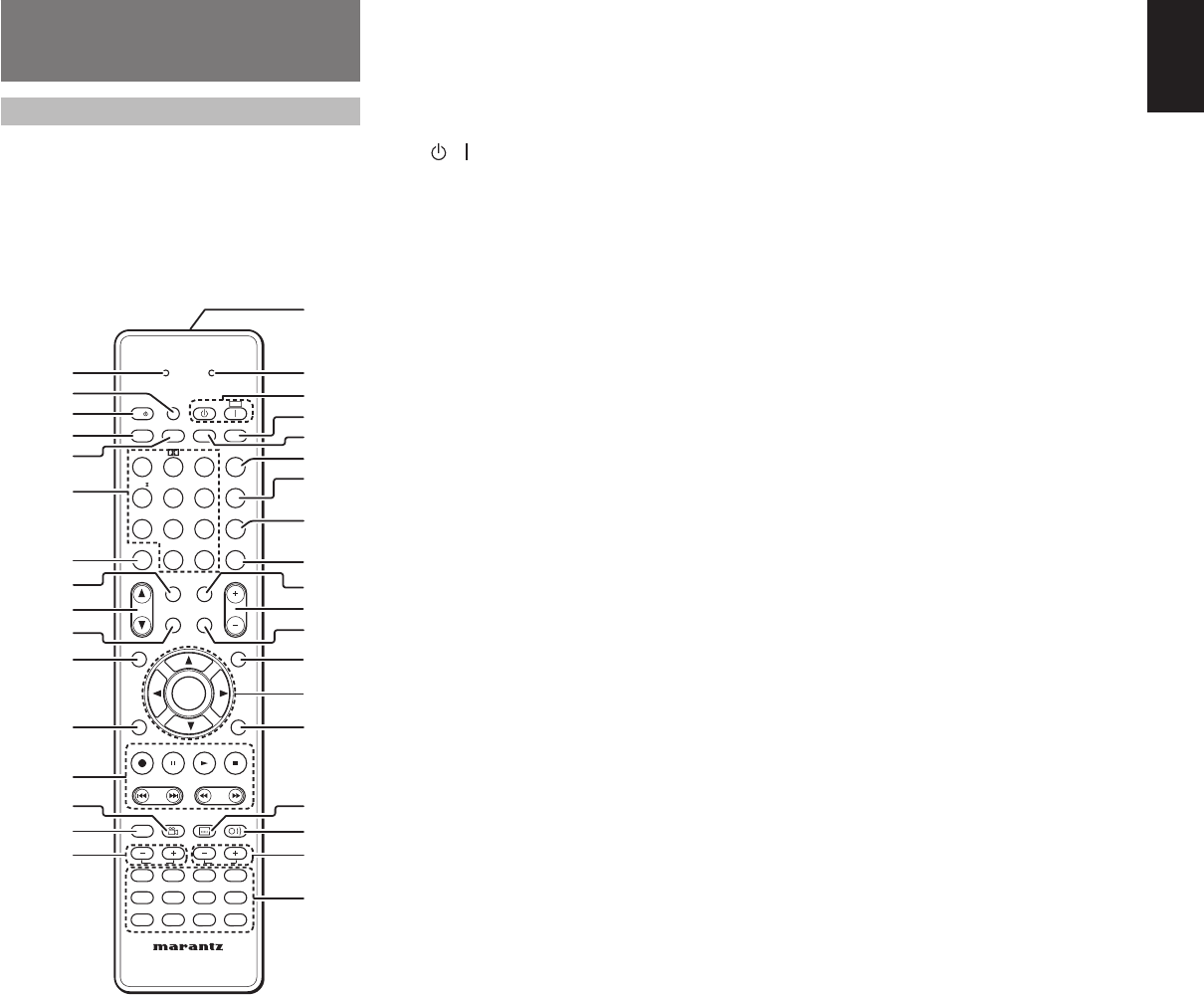
ENGLISH
9
!9 DIGITAL INPUT (Dig.1 - 5) /
OUTPUT (coaxial, optical)
These are the digital audio inputs and outputs. There
are 2 digital inputs with coaxial jacks, 3 with optical
jacks.
The inputs accept digital audio signals from a
compact disc, LD, DVD, or other digital source
component.
For digital output, there is 1 coaxial output and 1
optical output.
The digital outputs can be connected to MD
recorders, CD recorders, DAT decks, or other similar
components.
@0
VIDEO IN/OUT
(TV, DVD, VCR, DSS)
These are the video inputs and outputs. There
are 4 video inputs and 1 video output and each
one includes both composite video and S-video
confi gurations. Connect VCRs, DVD players, and
other video components to the video inputs.
The 1 video output channel can be used to connected
to video tape recorders for making recordings.
@1 HDMI INPUT / OUTPUT
This unit has 2 HDMI inputs and 1 HDMI output. The
input function can be selected from the OSD menu
system. (See page 19)
9/NIGHT button
Pressing this button prevents the Dolby Digital
signal from playback at a loud voice. This function
reduces the voice by 1/3 to 1/4 at maximum. Thus, it
eliminates the occurrence of an abruptly loud voice
at night. However, the function is valid only in the
case when the Dolby Digital signal is entered into
OPTICAL or COAXIAL and data to compress the
voice exists in the signal to be played back.
When this button is pressed, the “NIGHT” indicator
is illuminated.
0/7.1CH IN button
Press this button to select the output of an external
multi channel decoder.
(+10) A/D button
Used to switch between the analog and digital
inputs.
m CL (Clear) button
This button is used to erase the memory or program
of a source.
, SPKR A/B button
Used to select the speaker system.
The speaker system is switched in the following
sequence.
A → B → A+B → off
. CH/CAT3 (UP) / 4 (DOWN) buttons
These buttons are used to change channels.
⁄0 MULTI/CAT button
(When AMP mode is selected)
Used to turn on and off multi room.
⁄1 INFO button
(When AMP mode is selected)
When this button is pressed, the current setting are
displayed on the TV monitor.
⁄2 T.TONE/SET UP button
(When AMP mode is selected)
Used to enter the test tone menu.
REMOTE CONTROL
OPERATION
FUNCTION AND OPERATION
The provided remote control unit is a universal
remote controller. The POWER button, numeric
buttons and control buttons are used in common
across different input source components.
The input source controlled with the remote control
unit changes when one of the input selector buttons
is pressed.
z LEARN indicator
Indicates when the remote controller is in the LEARN
mode.
x SET button
This button is used to enter learn mode and preset
mode.
c / SOURCE ON/OFF button
This button is used to turn a specifi c source (such as
a DVD player) on or off independently from the rest
of the system.
v SLEEP button
This button is used for setting the sleep timer.
b DISPLAY button
Selects the display mode for the front display of the
SR6001.
n Numeric buttons
These buttons are used to switch between 0 to +10
of the source components.
If the source is set to the amplifi er, these buttons are
used to perform operations.
(When AMP mode is selected)
1/AUTO button
Used to select auto surround.
2/Dolby button
Used to select DOLBY mode.
3/dts button
Used to select dts mode.
4/CSII button
Used to select CSII mode.
5/EX/ES button
Used to select EX/ES mode.
6/VIRTUAL button
Used to select VIRTUAL mode.
7/M-CH ST button
Used to select Multi Channel Stereo.
8/STEREO button
Used to select STEREO mode.
TAPE
CAT
P.SCAN
CAT
T.MODE
-
T.DISP
F.DIRECT
PTY
TUNING
PRESET
-
++
123
456
789
0
+10
REMOTE CONTROLLER
RC5001SR
HT-EQ
MULTI/
SEND
MENU
SPKR A/B
ENTER
EXIT
INFO
CH/
INPUT
T.TONE
/SET UP
M-SPKR
MUTE
MD
CDR
CD
DVD
AMP
AUX2
VCR
TUNER
DSS
TV
EX/ES
VIRTUAL
CS
VOLUME
BASS
TREBLE
dts
P.DIRECT
l/
OFF
ON
SET
7.1CH IN
STEREO
NIGHT
M-CH ST
AUTO
SURROUND
SLEEP
DISPLAY
REC
AUDIO
ANGLE
SUB TITLE
DISC+
CH-SEL
V-OFF
ATT.
AUX1
A/D
LEARN
LIP SYNC/
MEMO
BAND
CL
SOURCE
z
m
.
⁄1
⁄2
⁄3
⁄6
⁄5
c
v
x
‹0
n
b
,
⁄0
⁄4
¤9
¤8
‹4
¤6
¤4
¤3
‹5
¤2
¤0
¤1
⁄7
⁄9
‹2
‹3
‹1
⁄8
¤5
¤7


















